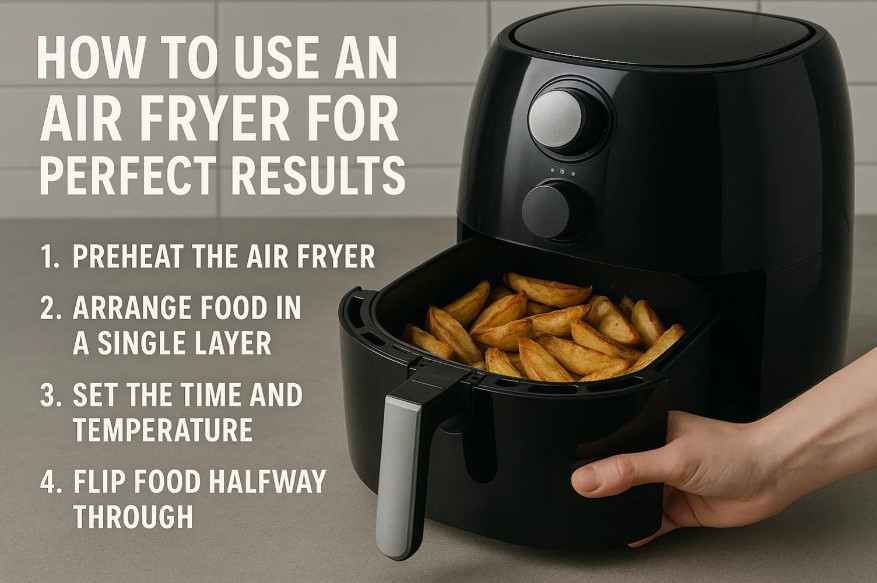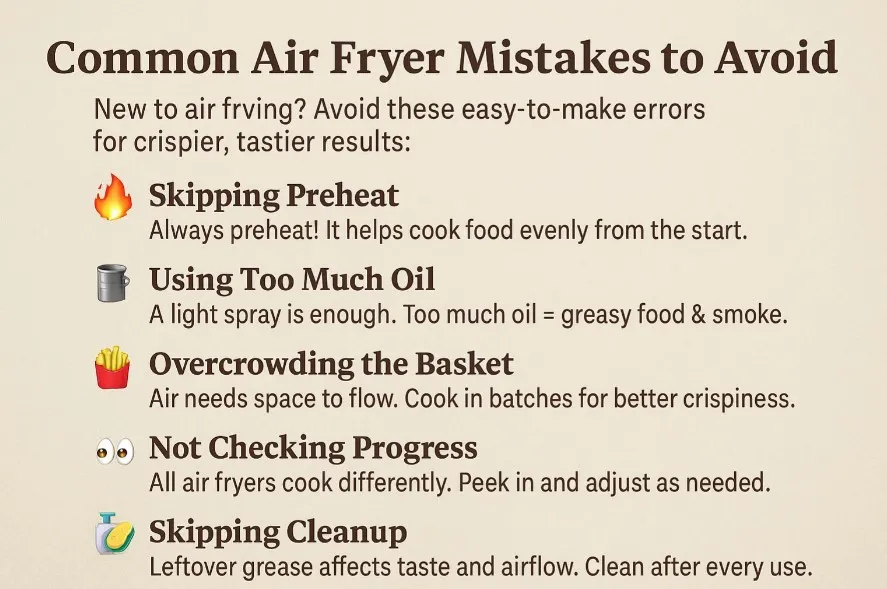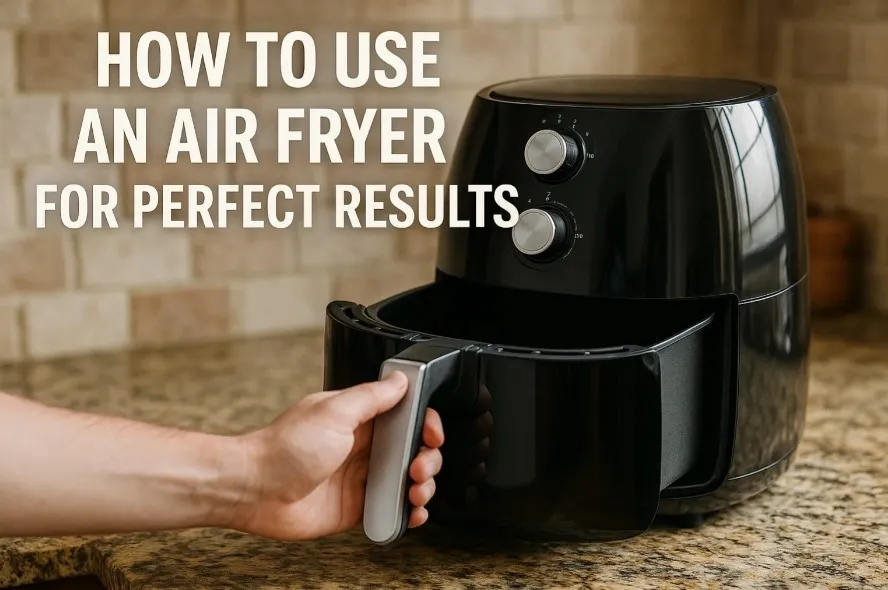For perfect air fryer results, preheat it for 3-5 minutes, avoid overcrowding the basket (single-layer cooking works best), and shake or flip food halfway for even crispiness!
I absolutely love cooking with my air fryer because it makes preparing meals both healthier and easier. It’s incredible how you can skip so much oil and still achieve crispy, delicious results. Did you know that air frying can cut calories by up to 80% compared to deep frying? On top of that, it reduces acrylamide levels in fried potatoes by 90%, which is a compound linked to cancer.
If you’re curious about how to use an air fryer, it’s actually much simpler than you might think. Here’s why I believe air fryers are a total game-changer:
- They require up to 25% less oil than traditional frying methods.
- They’re energy-efficient, helping you save money compared to using an oven.
Let’s dive into how to use an air fryer and discover how this amazing kitchen gadget can transform the way you cook!

Top Ideas
- Air frying cuts calories by up to 80% versus deep frying. It makes food healthier.
- Heat your air fryer for 3-5 minutes first. This helps cook food evenly and makes it crispy.
- Don’t pack the basket too full. This lets hot air move around and cooks food perfectly.
“Air fryers work best with dry surfaces. Patting food dry before cooking helps achieve maximum crispiness.” – Chef Lisa Adams
What Is an Air Fryer and How to Use It?
Understanding air frying technology
Air fryers cook food crispy without deep frying. They use fast-moving hot air, like convection ovens. This hot air cooks food evenly in a small space. The outside gets crispy, while the inside stays soft.
Here’s how air fryers work:
| Feature | Description |
|---|---|
| Technology | RapidAir moves hot air for even cooking and crunch. |
| Cooking Result | Crispy outside, soft inside, with little or no oil. |
| Air Flow | Special design ensures quick, tasty cooking every time. |
Air frying is healthier than deep frying. It uses less oil, cutting fat and calories. For example, fries cooked in an air fryer can have 80% less fat. Studies show air-fried food tastes similar to deep-fried food but is better for your health.
Setting up your air fryer for the first time
Setting up an air fryer is simple. Follow these steps:
- Take off all packaging, including plastic and cardboard.
- Wash the basket and crisper plate with warm, soapy water. Dry them well.
- Put the air fryer on a flat surface with space around it.
- Read the manual for setup tips and safety rules.
Once cleaned and ready, you can start cooking! Using an air fryer is easy. Follow the steps, and enjoy crispy meals soon.
Step-by-Step Guide: How to Use an Air Fryer?
Preparing your food and the air fryer
Before you start cooking, it’s important to prep both your food and your air fryer. Trust me, this step makes all the difference in getting those perfect, crispy results.
- Cut your ingredients evenly: Whether it’s veggies, chicken, or fries, make sure everything is cut into similar sizes. This helps them cook evenly.
- Pat food dry: If your ingredients are wet, pat them dry with a paper towel. Excess moisture can prevent crispiness.
- Lightly coat with oil or seasoning: A small amount of oil or seasoning goes a long way. Toss your food in a bowl to ensure everything is evenly coated.
For the air fryer itself:
- Preheat it (more on this in the next section).
- Make sure the basket is clean and dry.
- Avoid overcrowding the basket. Leave enough space for air to circulate around the food.
Here’s a handy table to help you ensure your food is cooked to safe internal temperatures:
| Product | Minimum Internal Temperature |
|---|---|
| Beef, Pork, Veal & Lamb (steak, chops, roasts) | 145°F (62.8°C) Allow to rest for at least 3 minutes |
| Ground Meats (beef, pork, veal, lamb) | 160°F (71.1°C) |
| Ham (fresh or smoked, uncooked) | 145°F (62.8°C) Allow to rest for at least 3 minutes |
| Fully Cooked Ham (to reheat) | 140°F (60°C) Ham packaged in USDA plants 165°F (73.9°C) For all other hams |
| All Poultry (whole birds, parts, ground poultry, and stuffing) | 165°F (73.9°C) |
| Eggs | 160°F (73.9°C) |
| Fish and Shellfish | 145°F (73.9°C) |
| Casseroles | 165°F (73.9°C) |
“The key to perfect air-fried chicken? Let it sit for a few minutes after cooking—this locks in juiciness.” – Food Blogger Mark Stevens
Preheating and selecting settings
Preheating your air fryer is a step you don’t want to skip. It ensures your food cooks evenly and gets that golden, crispy finish. Most air fryers only need 3-5 minutes to preheat. I usually set mine to the temperature I’ll be cooking at and let it run empty for a few minutes.
Here’s a quick tip: If your recipe doesn’t mention preheating, go ahead and do it anyway. It’s a small step that makes a big difference.
When it comes to selecting settings, many air fryers come with preset programs for common foods like fries, chicken, or fish. These can be super helpful if you’re new to air frying. If your air fryer doesn’t have presets, don’t worry. Just follow the recipe’s temperature and time guidelines.
Cooking, flipping, and checking progress
Now comes the fun part—cooking! Place your food in the basket in a single layer. Overcrowding can block the hot air from circulating, which means uneven cooking.
Here’s what I do:
- Set the timer for the recommended cooking time.
- Halfway through, open the basket and flip or shake the food. This step is crucial for even cooking. For example, when I make fries, I shake the basket at the 8-minute mark to ensure they’re crispy all over.
- Check the food’s progress. If it’s not done, continue cooking in 5-minute increments until it’s perfect.
Studies show that flipping or shaking the food halfway through cooking helps achieve even results. For instance, potato strips cooked at 200°C for 15 minutes turn out best when flipped at the 8-minute mark.
Here’s a quick comparison of cooking methods and their benefits:
| Cooking Method | Acrylamide Level (μg/kg) | Oil Absorption Reduction |
|---|---|---|
| Air Fryer (Acti-Fryer) | 182 ± 24 | 80% less oil absorption |
| Air Fryer | 91 ± 13 | 80% less oil absorption |
| Deep Frying | 126 ± 15 | N/A |
| Microwave | 270 | N/A |
| Oven Frying | Lower than Air Frying | N/A |
Serving and enjoying your meal
Once your food is cooked to perfection, it’s time to serve and enjoy! Use oven mitts to remove the basket, as it can get pretty hot. Transfer your food to a plate and let it cool for a minute or two before digging in.
I love pairing air-fried dishes with dips or sauces. For example, crispy chicken wings go great with ranch or buffalo sauce, while fries are perfect with ketchup or aioli.
Quick Tip: If you’re cooking multiple batches, keep the first batch warm in the oven at a low temperature while the next one cooks.
Air frying is not just about cooking—it’s about creating meals that are healthier and just as delicious. Once you get the hang of it, you’ll wonder how you ever lived without it!
Tips and Mistakes to Avoid for Perfect Results
Essential tips for even cooking
Getting perfectly cooked food from your air fryer isn’t hard, but a few tricks can make a big difference. Here’s what I’ve learned:
- Don’t overcrowd the basket: Always leave space between pieces of food. This allows the hot air to circulate and cook everything evenly.
- Shake or flip halfway through: For foods like fries or chicken nuggets, shaking the basket or flipping the pieces ensures every side gets crispy.
- Use a light coat of oil: Even though air fryers don’t need much oil, a small amount can help your food brown and crisp up beautifully. I like to use a spray bottle for even coverage.
- Preheat your air fryer: Preheating helps the food start cooking right away, giving it that golden, crispy texture.
Pro Tip: If you’re cooking something delicate, like fish, use parchment paper or a silicone liner to prevent sticking.
Common mistakes to avoid

When I first started using my air fryer, I made a few mistakes that led to soggy fries or unevenly cooked chicken. Here are some common pitfalls to watch out for:
- Skipping the preheat step: I know it’s tempting to skip this, but preheating ensures your food cooks evenly from the start.
- Using too much oil: Adding too much oil can make your food greasy and even cause smoke. Stick to a light spray or a teaspoon.
- Overcrowding the basket: Piling food on top of each other blocks airflow, leading to uneven cooking. Cook in batches if needed.
- Not checking progress: Every air fryer is a little different. Keep an eye on your food and adjust the time or temperature as needed.
- Neglecting to clean after use: Grease and food residue can build up quickly, affecting the taste of your food and the performance of your air fryer.
Quick Tip: If you’re unsure about cooking times, start with less time and add more as needed. It’s easier to cook a little longer than to fix overcooked food!
Cleaning and maintaining your air fryer

Keeping your air fryer clean is essential for both safety and performance. I’ve found that regular maintenance not only extends the life of the appliance but also ensures my food always tastes fresh. Here’s how I do it:
- After each use:
- Remove the basket and tray, and wash them with warm, soapy water.
- Wipe down the interior and exterior with a damp cloth.
- Avoid using abrasive cleaners or scouring pads to protect the nonstick coating.
- Weekly deep cleaning:
- Unplug the air fryer and let it cool completely.
- Mix equal parts baking soda and water to create a paste for tough stains. Apply it to the stains, let it sit for a few minutes, and then wipe it off.
- Use a solution of water and vinegar for a thorough clean.
- Rinse and dry all parts before reassembling.
Note: Never submerge the air fryer in water or put it in the dishwasher unless the manual says it’s safe.
Following these steps has made a huge difference for me. Studies even show that kitchens following proper cleaning guidelines experience fewer equipment problems. It’s worth the effort to keep your air fryer in top shape!
Using an air fryer has made cooking so much easier. It’s fast, simple, and makes meals healthier. I’ve tried cooking fries, pizza, and even chicken. The food always turns out crispy and evenly cooked.
- 🍕 Pizza and fries come out crispy and tasty.
- 🐔 Whole chicken cooks well, but size is important.
Give it a try today!
FAQs For How To Use an Air Fryer for Perfect Results
How much oil should I use in an air fryer?
You only need a small amount—about 1-2 teaspoons. I like using a spray bottle for even coverage. It keeps food crispy without being greasy.
Can I cook frozen food in an air fryer?
Absolutely! I’ve cooked frozen fries, nuggets, and veggies straight from the freezer. Just add a couple of extra minutes to the cooking time for perfect results.
What foods shouldn’t I cook in an air fryer?
Avoid foods with wet batters, like tempura. They don’t crisp up well. Also, leafy greens can fly around due to the fan. Stick to sturdier ingredients.
Pro Tip: Experiment with different foods to see what works best. You’ll be surprised at how versatile your air fryer can be!
Conclusion
Learning how to use an air fryer for perfect results is simple once you know the basics. From preheating to avoiding overcrowding, small adjustments make a big difference. Whether you’re cooking fries, veggies, or chicken, your air fryer can deliver crispy, delicious meals with minimal effort.
“An air fryer isn’t just a gadget—it’s a game-changer for quick, healthy cooking.” – Nutritionist Sarah Lee
Now that you’re equipped with these tips, it’s time to start air frying like a pro! Happy cooking!

